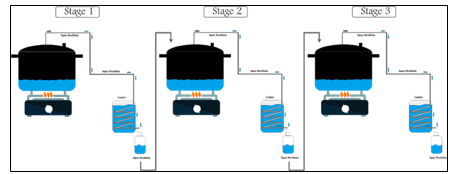Analysis water content of Seawater Desalination Technology by Using Multistage Distillation
DOI:
https://doi.org/10.26555/ijce.v2i1.675Keywords:
desalination, distillation, seawater, total hardness, TDSAbstract
Desalination technology, which has been the most widely utilized method of meeting the requirement for clean water for the past 50 years, can be employed in attempts to use seawater. The purpose of this study is to ascertain how variations in the composition of distilled water are affected by the multistage distillation of seawater from Cemara Sewu Beach, Bantul, Yogyakarta. LPG gas is used as fuel to heat sea water during the distillation process. To obtain distilled water, the seawater vapor is then condensed. Subsequently, the distillation procedure is executed in three phases, with every phase being evaluated using the distilled water. The overall CaCO3 hardness level in the first stage of distilled water is still high, thus it does not exceed clean water quality criteria. Meanwhile, in the second and third stages, there are two parameters, namely pH and total hardness level, which do not meet the clean water requirements. In general, the first stage of distilled water is sufficient to be processed into clean water with the addition of water hardness treatment. Repeated distillation has a tendency to reduce pH, total hardness, TDS, fluoride, nitrate and detergent.
References
M. Djana, “Analisis Kualitas Air Dalam Pemenuhan Kebutuhan Air,” J. Agroqua, vol. 8, no. 32, pp. 81–87, 2023.
M. A. Ahmed, S. Amin, and A. A. Mohamed, “Fouling in reverse osmosis membranes: monitoring, characterization, mitigation strategies and future directions,” Heliyon, vol. 9, no. 4, p. e14908, 2023, doi: 10.1016/j.heliyon.2023.e14908.
B. Kuntoro and Hardjono, “Pengelolaan Air Bersih Daerah Perbukitan Di Prambanan, Sleman, Yogyakarta,” Ekp, vol. 13, no. 3, pp. 1576–1580, 2017.
G. Y. Dewantara, B. M. Suyitno, and I. G. E. Lesmana, “Desalinasi Air Laut Berbasis Energi Surya Sebagai Alternatif Penyediaan Air Bersih,” J. Tek. Mesin, vol. 07, pp. 3–6, 2018.
H. T. P. Mbusa, “Manajemen Pelayanan Air Bersih di Desa Maropokot Kecamatan Aesesa Kabupaten Nagekeo Provinsi Nusa Tenggara Timur,” Molecules, vol. 2, no. April, pp. 1–58, 2020.
U. Atikah, R. Purnaini, and G. C. Asbanu, “Analisis Kualitas Air Baku dan Kualitas Air Hasil Produksi pada Instalasi Pengolahan Air (IPA) Unit Mukok PDAM Tirta Pancur Aji Kota Sanggau,” J. Teknol. Lingkung. Lahan Basah, vol. 11, no. 2, p. 297, 2023, doi: 10.26418/jtllb.v11i2.64525.
N. Muhamad and I. Kurnia, “Potensi Air Laut sebagai Sumber Air Tawar dan Pembangkit Energi,” Teknol. Bandung, no. December, pp. 0–12, 2015.
Yaningsih, T. Istanto, and W. E. Juwana, “Pengaruh Kecepatan Putaran Kompresor Terhadap Produktivitas Unit Desalinasi Berbasis Pompa Kalor Dengan Proses Humidifikasi dan Dehumidifikasi,” Mechanical, vol. 5, no. 2, pp. 23–28, 2014.
R. F. Gani, N. A. Putri, S. S. Habibi, and ..., “Desalinasi Dengan Metode Evaporasi Sebagai Penyedia Air Bersih Di Desa Kurandak,” J. Pasopati …, vol. 4, no. 4, pp. 226–230, 2022, [Online]. Available: https://ejournal2.undip.ac.id/index.php/pasopati/article/view/16126%0Ahttps://ejournal2.undip.ac.id/index.php/pasopati/article/download/16126/8261
G. R. Ersa, “Kajian Alternatif Teknologi Desalinasi Dalam Produksi Air Tawar Untuk Desa Labuan Bajo, Ntt,” J. Purifikasi, vol. 20, no. 1, pp. 1–14, 2021, doi: 10.12962/j25983806.v20.i1.400.
J. Kavitha, M. Rajalakshmi, A. R. Phani, and M. Padaki, “Pretreatment processes for seawater reverse osmosis desalination systems—A review,” J. Water Process Eng., vol. 32, no. August, p. 100926, 2019, doi: 10.1016/j.jwpe.2019.100926.
A. N. Angelakis et al., “Desalination: From ancient to present and future,” Water (Switzerland), vol. 13, no. 16, 2021, doi: 10.3390/w13162222.
S. H. Abdulloh, “Desalinasi Air dengan Memanfaatkan Energi Terbarukan,” Pengolah. Air dengan Menggunakan Energi Terbarukan, no. December, pp. 1–8, 2015.
M. Marjuni, O. Minarto, and S. C. Wahyono, “Modifikasi Sirkulasi Air Pendingin Alat Destilasi pada Proses Pembuatan Akuades,” J. Fis. Flux J. Ilm. Fis. FMIPA Univ. Lambung Mangkurat, vol. 18, no. 1, p. 16, 2021, doi: 10.20527/flux.v18i1.8888.
L. Febrina and A. Ayuna, “Studi Penurunan Kadar Besi (Fe) dan Mangan (Mn) dalam Air Tanah Menggunakan Saringan Keramik,” J. Teknol., vol. 7, no. 1, pp. 36–44, 2014, [Online]. Available: https://jurnal.umj.ac.id/index.php/jurtek/article/download/369/341
A. Maulina Najib and C. Nuzlia, “Uji Kadar Flourida Pada Air Minum Dalam Kemasan (Amdk) Dan Air Sumur Secara Spektrofotometri Uv-Vis,” Amina, vol. 1, no. 2, pp. 84–90, 2020, doi: 10.22373/amina.v1i2.43.
Ita Emilia, “Analisa kandungan nitrat dan nitrit dalam air minum isi ulang menggunakan metode spektrofotometri uv-vis,” J. Indobiosains, vol. 1, no. 1, pp. 38–44, 2019, [Online]. Available: http://univpgri-palembang.ac.id/e_jurnal/index.php/biosains
Rachmat, P. Sidebang, and I. Purwandari, “pada air baku dan penilaian risiko kesehatan masyarakat di Kecamatan Babakan Madang Kabupaten Bogor,” J. Cimmunity Med. Public Heal., vol. 35, no. 3, pp. 97–105, 2019.
W. Krisno, R. Nursahidin, R. Y. Sitorus, and F. R. Ananda, “Penentuan Kualitas Air Minum Dalam Kemasan Ditinjau Dari Parameter Nilai Ph Dan Tds,” Semin. Nas. Penelit. dan Pengabdi. Masy. 2021, no. 416, pp. 188–189, 2021.
U. Nurullita, R. Astuti, and M. Z. Arifin, “Pengaruh lama kontak karbon aktif sebagai media filter terhadap persentase penurunan kesadahan caco 3 air sumur artetis,” J. Kesehat. Masy. Indones., vol. 6, no. 1, pp. 48–56, 2013, [Online]. Available: http://jurnal.unimus.ac.id48
J. A. Wijayanti, D. Anita, E. Dewi, and S. Yuliati, “Produksi Air Minum Dari Air Pdam Dengan Cara Dimasak Dan Menggunakan Metode Reverse Osmosis,” Pros. Semin. Mhs. Tek. Kim., vol. 1, no. 1, pp. 55–61, 2020.

Downloads
Published
Issue
Section
License
Copyright (c) 2024 Sofyan Hadi, Adi Permadi, Maryudi, Arief Syamsuddin, Ahmad Fatwa Zufar

This work is licensed under a Creative Commons Attribution-ShareAlike 4.0 International License.



